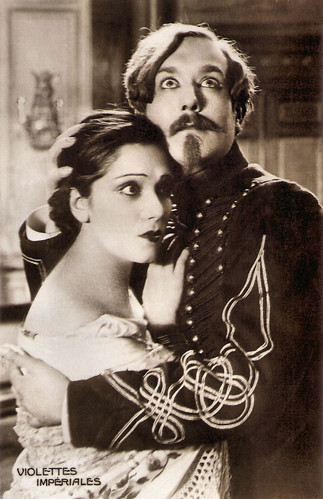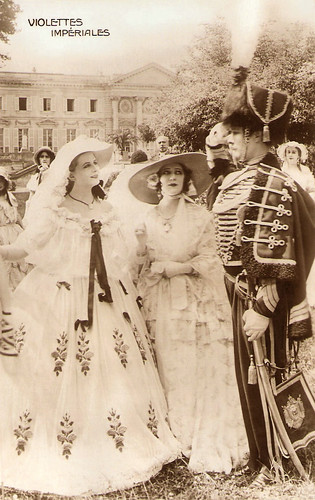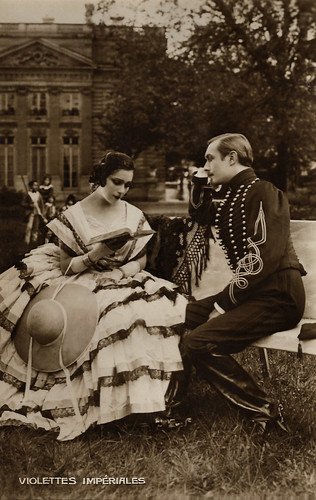
French postcard by Jean de Merly, Paris. Photo: Raquel Meller in Violettes impériales/Imperial Violets (1924).

French postcard. Photo: Raquel Meller and André Roanne in Violettes impériales/Imperial Violets (1924).
Overthrown by the anarchist's bomb
Spanish diva Raquel Meller (1888-1962) was already a highly popular singer before debuting as a film actress in 1919.
La Meller performed not only in Spain but also in France and the USA. Songs such as 'La Violetera', 'El Relicario', and 'Flor del Mal' became standards - thanks to her interpretations.
Meller was also a hit on the big screen. She made her film debut in the Spanish film Los arlequines de seda y oro/The Harlequins of Silk and Gold (Ricardo de Baños, 1919).
In France, she also starred in several films. She is best-remembered for Violettes imperiales (Henry Roussel, 1924), a historical romantic drama set during the reign of Napoleon III of France.
Meller plays a Spanish flower girl who saves an attack on the life of the French empress Eugénie de Montijo (played by Suzanne Blanchetti), by taking her place in her carriage. When the carriage is overthrown by the anarchist's bomb, the girl survives because of - yes! - the masses of violets in the imperial carriage, the empress' favourite flowers.
French postcard by Cinémagazine-Edition. Photo: publicity still for Violettes impériales/Imperial Violets (1924). Shot on location in Seville, Spain, where the future Empress Eugénie of France (Suzanne Bianchetti) meets the flower girl Violetta (Raquel Meller).
French postcard by Cinémagazine-Edition. Photo: publicity still for Violettes impériales/Imperial Violets (1924), starring Raquel Meller as Violetta, the poor flower girl from Seville who becomes the protégée of the Empress Eugénie of France. Sepia version of the black & white card above.
French postcard by Cinémagazine-Edition. Photo: publicity still for Violettes impériales/Imperial Violets (1924). Center stands Suzanne Bianchetti as Empress Eugénie, in the back the Chateau de Compiègne, Napoleon III's original residence. The composition recalls Franz-Xaver Winterhalter's famous painting The Empress Eugénie Surrounded by her Ladies in Waiting (1855, Chateau de Compiègne).
Jeune premier
A summary of the story: At Grenada, in 19th Century Spain, Eugénie de Montijo (Suzanne Blanchetti) asks a gypsy girl, Violetta (Raquel Meller), to read her fortune in her hand.
Emboldened by Violetta's prediction that she is to become a queen, Eugénie heads for Paris, accompanied by her mother and their servant Juan de Ayala (Jimmy O'Kelly). The latter uses his seductive charms to persuade a team of seamstresses to make a grand dress for Eugénie, so that she may attend a ball at the Tuileries, hosted by French Emperor Napoleon III (Daurelly).
Naturally, Eugénie wins the heart of Napoleon III, but in doing so she makes a dangerous enemy in her rival Madame de Pierrefeu (Claude France). Once Eugénie has been installed as empress, Madame de Pierrefeu swears that she will have her revenge...
Meller's film partner in the film was Jeune premier André Roanne (1896-1959). He had a long-standing career in French cinema with more than 90 films.
Henry Roussel was not only the director of Violettes impériales/Imperial Violets (1924) but also the producer and the scriptwriter. The film's sets were designed by the art director Robert Gys and the cinematography was done by Jules Kruger and Paul Portier.
French postcard by Cinémagazine-Edition. Photo: André Roanne in Violettes impériales/Imperial Violets (1924).

French postcard by Cinémagazine-Edition. Photo: publicity still for Violettes impériales/Imperial Violets (1924). Visible in the back is the Chateau de Compiègne, Napoleon III's residence.
An Abrupt Career End
In 1932, Henry Roussel made a sound version of the film, again with Raquel Meller and Suzanne Bianchetti.
In 1952 an operetta version was made of the film based on a stage operetta with music composed by Jacques Météhen and lyrics written by Paul Achard, René Jeanne, and Henri Varna.
This version was without La Meller. Violetta was played by Carmen Sevilla, while the empress was played by Simone Valère. However, in this remake, the male character was enhanced to feature the singing talents of tenor Luis Mariano.
The Spanish Civil War and the Second World War had put an abrupt end to Raquel Meller's career. Raquel Meller had first left for Argentina and later retired in Barcelona.
Some years ago, a tinted copy of the silent version of Violettes impériales/Imperial Violets (1924) was beautifully restored by the BFI. A clip of the film can be seen in Kevin Brownlow's documentary series Cinema Europe (1995), but we are still waiting for a DVD of the film.
French postcard by Cinémagazine-Edition. Photo: Raquel Meller as Violetta and Suzanne Bianchetti as Empress Eugénie in Violettes impériales/Imperial Violets (1924).
French postcard by Cinémagazine-Edition. Photo: Raquel Meller as Violetta, the poor flower girl from Seville who becomes the protégée of the Empress Eugénie of France in Violettes impériales/Imperial Violets (1924).

French postcard by Cinémagazine-Edition. Photo: Raquel Meller and André Roanne in Violettes impériales/Imperial Violets (Henry Roussel, 1924).
Sources: Films de France, Wikipedia (French), and IMDb.
This post was last updated on 14 February 2021.
No comments:
Post a Comment